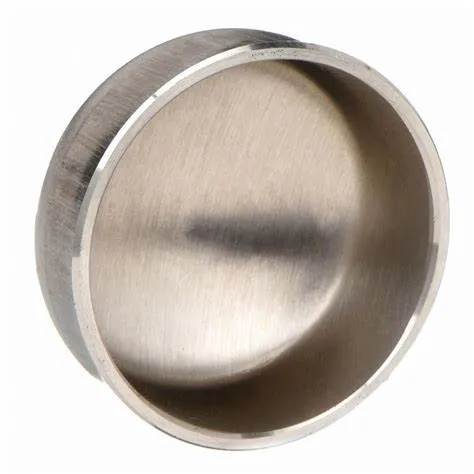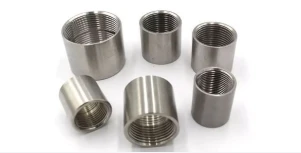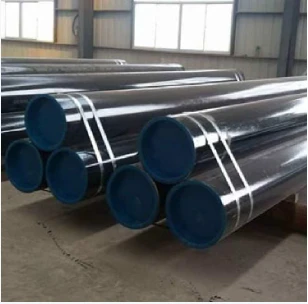Tha JIS B2311 na Inbhe Gnìomhachais Iapanach a tha a’ còmhdach criathran pìoba tàthaidh cnap, a’ toirt a-steach bonaidean a thathas a’ cleachdadh ann an siostaman pìobaireachd. Bidh ceapan tàthaidh butt a’ frithealadh adhbhar deireadh pìoba a dhùnadh, a’ toirt seachad ròn gus casg a chuir air aodion no truailleadh. Seo ro-ràdh mu chaiptean tàthaidh butt JIS B2311:
- 1. JIS B2311 Standard:
- - Tha inbhe JIS B2311 a’ sònrachadh riatanasan airson dealbhadh, tomhasan, stuthan, saothrachadh agus deuchainn innealan tàthaidh butt, a ’toirt a-steach ceapan, ann an siostaman pìobaireachd.
- - Bidh an inbhe a’ dèanamh cinnteach gu bheil caiptean a chaidh a thoirt a-mach a rèir inbhean JIS a ’coinneachadh ri inbhean càileachd agus gu bheil iad co-chòrdail ri pàirtean pìobaireachd eile.
- 2. Butt-Welding Cap:
- - Tha caip tàthaidh butt, a rèir JIS B2311, na uidheamachadh a chaidh a dhealbhadh gus ceann pìoba a chòmhdach agus a ròn gu tèarainte, a’ tabhann dìon agus a’ cumail suas ionracas an t-siostam pìobaireachd.
- - Bithear a’ cleachdadh bonaidean ann an suidheachaidhean far a bheil feum aig ceann na pìoba dùnadh, gu maireannach no airson ùine, gus casg a chuir air aodion, truailleadh no gus crìoch a chuir air an t-siostam.
- 3. Stuth agus Togail:
- - Tha ceapan tàthaidh butt fo shònrachaidhean JIS B2311 rim faighinn ann an grunn stuthan leithid stàilinn gualain, stàilinn gun staoin, agus stàilinn alloy gus coinneachadh ri diofar riatanasan tagraidh.
- - Tha na ceapan sin air an dèanamh le bhith a’ cleachdadh dhòighean togail àbhaisteach gus dèanamh cinnteach gu bheil ceangal làidir gun aodion ann nuair a thèid an tàthadh gu deireadh pìoba.
- 4. Iarrtas agus Buannachdan:
- - Bidh ceapan tàthaidh cnap a’ lorg thagraidhean ann an grunn ghnìomhachasan, a’ gabhail a-steach ola is gas, pròiseasan ceimigeach, ionadan làimhseachaidh uisge, agus barrachd far am feumar crìoch a chuir air pìoban gu tèarainte.
- - Bidh caiptean a’ dìon cinn pìoba bho eileamaidean àrainneachd, a’ cur casg air truailleadh, agus a’ cuideachadh le bhith a’ cumail suas glainead is ionracas an t-siostam pìobaireachd.
- 5. Stàladh agus Welding:
- - Tha cleachdaidhean stàlaidh ceart, a’ gabhail a-steach co-thaobhadh ceart, ullachadh ceann na pìoba, agus dòighean tàthaidh, riatanach nuair a thathar a’ stàladh bonaidean tàthaidh butt gus dèanamh cinnteach à ròn teann agus dìon-aodion.
- - Tha tàthadh na dhòigh cumanta air caiptean a cheangal ri pìoban, a’ toirt seachad dùnadh tèarainte is maireannach a sheasas ri cuideam, atharrachaidhean teothachd, agus sruthadh lionn taobh a-staigh an t-siostam.
- Ann an geàrr-chunntas, tha ceapan tàthaidh butt JIS B2311 nam pàirtean deatamach a thathas a’ cleachdadh ann an siostaman pìobaireachd gus deireadh pìoban a ròn agus a dhìon gu tèarainte. Tha na ceapan sin a rèir riatanasan àbhaisteach gus dèanamh cinnteach à càileachd, earbsachd agus co-chòrdalachd taobh a-staigh tagraidhean gnìomhachais far a bheil feum air dùnadh agus dìon pìoban.
What Is a Butt Welding Cap and How Is It Used in Industrial Piping?
In industrial piping systems, end-of-line sealing and branch closures require robust solutions. A butt welding cap serves as a critical component for terminating pipes securely. By providing a seamless, welded closure, this fitting maintains system integrity, prevents leaks, and supports compliance with industry standards.
What Is a Butt Welding Cap?
A butt welding cap—also called a pipe end cap or buttweld end cap—is a round fitting designed to close off the end of a pipe. It’s manufactured to match the pipe’s outer diameter and schedule, with either a hemispherical or flat face. To install, both the pipe end and cap are beveled to form a V‑groove, enabling full‑penetration, fusion welds. Common materials include carbon steel, stainless steel, nickel alloys, and other engineered grades, chosen to satisfy pressure, temperature, and corrosion‑resistance requirements.
How Is Butt Welding Cap Used in Industrial Piping?
Butt welding caps find application across oil & gas, petrochemical, power generation, water treatment, and general process industries for both permanent and temporary closures. During hydrostatic testing, technicians install caps to seal off sections of piping while monitoring for leaks. In new construction or retrofit projects, caps terminate branch lines, future tie‑in spools, or dead‑end mains until system expansion. Welders prepare each joint by cleaning and beveling surfaces, aligning the cap precisely, and executing a root pass followed by filler passes per the qualified Welding Procedure Specification (WPS). Post‑weld heat treatment and non‑destructive examination (NDE)—such as radiography or ultrasonic testing—verify weld integrity and compliance with ASME B16.9 and related standards. Additionally, temporary caps enable safe isolation during maintenance, allowing for segment testing and dewatering under regulatory protocols.
Benefits and Best Practices
Butt welding caps offer a smooth‑bore transition that minimizes flow disruption and stress concentration. Their full‑penetration welds deliver exceptional structural strength and leak resistance. To optimize performance, engineers should:
Select caps with matching material grades and wall thicknesses
Adhere to proper bevel angles and joint fit‑up tolerances
Follow qualified WPS protocols rigorously
Consider cladding or protective coatings in corrosive environments to extend service life
Regular inspection and thorough documentation ensure long‑term reliability and safe operation under demanding conditions.
Butt welding caps are indispensable components for achieving durable, leak‑proof pipe terminations in a wide range of industrial applications.
Butt Welding Cap FAQs
What is a butt welding cap?
|
What materials are commonly used?
|
What standards govern butt welding caps?
|
How are butt welding caps installed?
|
Where are butt welding caps typically used?
|
What are the advantages of threaded caps?
|
















